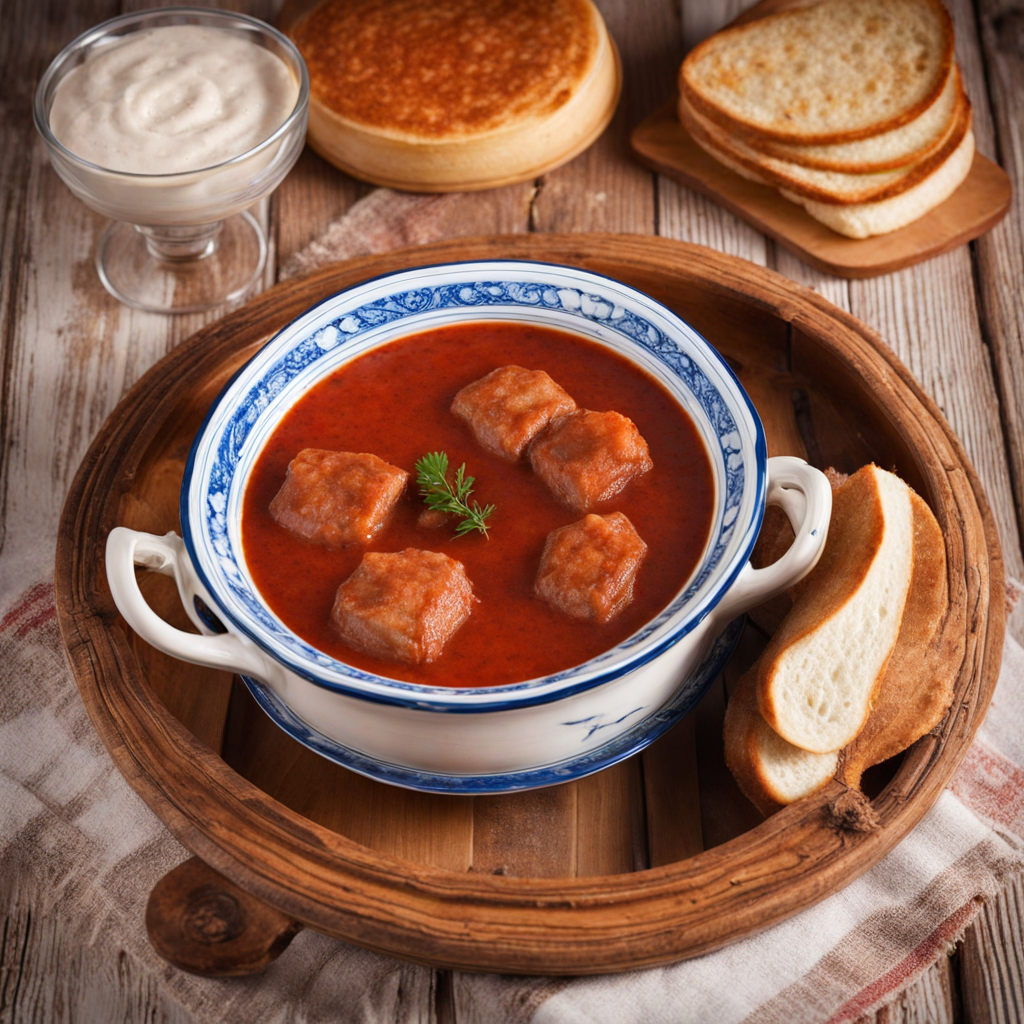Salted Pork Fat
Salted Pork Fat, known as "salo" in Belarus, is a beloved delicacy that embodies the essence of traditional Slavic cuisine. This mouthwatering treat is made from the rich layers of pork fat, which are generously seasoned with salt and sometimes infused with spices such as garlic, black pepper, or bay leaves. The salting process not only preserves the fat but also enhances its flavor, resulting in a savory, creamy texture that melts in your mouth. Often enjoyed as a simple snack, sliced thinly and served on dark rye bread, salted pork fat is a staple in Belarusian households, cherished for its robust taste and comforting qualities. One of the remarkable aspects of salted pork fat is its versatility. While it can be enjoyed raw, chilled, or at room temperature, it can also be paired with various accompaniments to elevate the tasting experience. Traditionally, it’s served with pickled vegetables, such as cucumbers or tomatoes, which provide a refreshing contrast to the richness of the fat. Additionally, it is often accompanied by a shot of vodka, which complements the salty flavors and enhances the overall experience, making it a popular choice during gatherings and celebrations. As you explore the culinary landscape of Belarus, indulging in salted pork fat allows you to connect with the country's cultural heritage. This dish is not just about flavor; it’s a celebration of community and tradition. Whether enjoyed at a festive occasion or as part of a cozy family meal, salted pork fat invites you to savor the simple pleasures of life, embodying the warmth and hospitality that Belarus is known for. Each bite tells a story of the land, the people, and their deep-rooted connection to food that nourishes both body and soul.
How It Became This Dish
The History of Сало: A Culinary Staple of Belarus #### Origins Сало, pronounced as "salo," is a traditional Eastern European food that holds a special place in the culinary landscape of Belarus. This delicacy, primarily composed of cured pork fat, has roots that trace back centuries, intertwining with the agricultural and social practices of the region. The origins of salo can be linked to the need for preservation methods in a harsh climate, where cold winters necessitated the development of ways to store food for extended periods. Historically, pork has been a significant part of the Belarusian diet, given the prevalence of pig farming throughout the region. Peasants would raise pigs as a source of meat, and salting and curing were necessary techniques to ensure the meat and fat could last through the long winters. As families would process their pigs, the fat was often set aside for curing, leading to the creation of salo as we know it today. #### Cultural Significance Salo occupies a prominent position in Belarusian culture and cuisine. It is more than just food; it is a symbol of hospitality, tradition, and national pride. In Belarus, salo is often served as part of a larger feast, accompanied by rye bread, garlic, and pickles. The act of sharing salo is deeply embedded in social customs, reflecting a welcoming spirit among families and friends. In Belarusian folklore and traditions, salo is associated with various rituals and festivities. It is commonly present at weddings, holidays, and family gatherings, serving as a bridge between generations. The preparation of salo can also be viewed as an art form, with families passing down their unique recipes and methods through generations. Salo is often celebrated in Belarusian literature and songs, where it is portrayed as a beloved staple of the nation’s diet. The phrase “salo is the best friend of a Belarusian” encapsulates the affection people have for this food. It conveys not only the nutritional value of salo but also its role in bonding communities and families. #### Development Over Time As Belarusian society evolved, so did the practices surrounding salo. In the 19th and early 20th centuries, the methods of producing salo became more refined. The introduction of spices such as black pepper, paprika, and garlic enhanced its flavor, while smoking became a popular technique to impart a unique taste. These variations reflect the influence of neighboring cultures and the movement of people across regions. During the Soviet era, salo gained further recognition as an essential part of the national diet. Despite the challenges of food rationing and shortages, salo remained readily available and continued to symbolize resilience and resourcefulness. In this period, it was commonly served with vodka, creating a cultural pairing that has endured over time. The tradition of “zakuski,” or appetizers, which includes salo, became a staple in social gatherings, highlighting the importance of food in fostering camaraderie. In contemporary Belarus, salo is experiencing a renaissance. With the rise of the farm-to-table movement and a growing interest in traditional foods, many chefs and home cooks are rediscovering the art of making salo. Artisan producers are experimenting with flavors, incorporating local herbs and spices, and even creating gourmet varieties that appeal to modern palates. This resurgence reflects a broader trend in Belarus and beyond, where people are increasingly valuing traditional, locally-sourced foods over mass-produced alternatives. Modern technology has also played a role in the evolution of salo. While traditional methods of curing remain popular, advancements in food preservation techniques have allowed for greater consistency and accessibility. Vacuum sealing, refrigeration, and controlled curing environments have made it possible to produce salo year-round, ensuring that this beloved food is always available. #### Salo in Global Cuisine As globalization continues to shape culinary landscapes, salo has begun to attract attention beyond Belarus. The growing interest in Eastern European cuisine has led to the inclusion of salo in various international culinary festivals and events. Chefs around the world are experimenting with salo, incorporating it into innovative dishes that highlight its rich flavor and texture. In recent years, salo has also found its place in gourmet food markets and restaurants, often presented as a delicacy comparable to prosciutto or pancetta. Some chefs serve it thinly sliced, drizzled with high-quality olive oil and accompanied by artisanal bread and pickled vegetables, showcasing its versatility and appeal to a broader audience. #### Conclusion Salo is much more than just cured pork fat; it is a cultural icon that embodies the spirit of Belarusian heritage. Its origins in rural communities, its significance in social customs, and its evolution over time reflect the resilience and creativity of the Belarusian people. As salo continues to adapt to contemporary tastes and trends, it remains a cherished part of the national identity—a testament to the importance of tradition in an ever-changing world. In exploring the rich history of salo, we uncover not only the story of a food but also the narrative of a people, their struggles, and their triumphs. Whether enjoyed in a rustic village home or a modern urban restaurant, salo serves as a delicious reminder of Belarus’s vibrant culinary culture and its enduring legacy in the hearts and kitchens of its people.
You may like
Discover local flavors from Belarus







